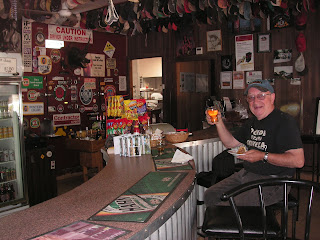
If you have seen the film “Australia” that’s what the countryside around here is like, in fact Nic and Hugh were up at Kununurra for about 4 weeks on location. One particular distinctive aspect of the countryside is the Boab tree, which come in all shapes and sizes, some so big they were hollowed out and used for storage or to live in.
Since leaving Kununurra we have been covering a bit of territory - an overnight stay at Halls Creek, an old gold mining town, then on to Fitzroy Crossing where in days gone by in the dry season there was an crossing of the Fitzroy River. We stayed one night and tried our hand at fishing in the river - no luck! Yesterday we arrived in Derby, where the Fitzroy River meets the sea. When in flood the only other river in the world that moves faster is the Amazon!
Derby is famous for having huge tidal variations, up to 11 metres. The tourist office say there is good fishing off the wharf, the story usually goes something like this “if there are indigenous women fishing there, then it’s a good time and place to try your luck” - we have had this advice many many times but somehow it doesn’t work for us. We went down to the wharf, live cattle exports happen there, but it was very quiet yesterday.
We went up to the local Woolies to stock up on fruit and veg. Coming into WA from NT there is a quarantine on fruit and veg and no fresh produce can be brought in - I made a vegetable curry with the fresh stuff we had and it lasted us for 5 nights so we were looking forward to a change. We also wanted to stock up on booze, it is pension week this week and the grog shop was buzzing, indigenous locals with laden trolleys, not a good sight. There are limits on what you can buy, e.g. no cask wine here only bottles and no port, but that doesn’t seem to make much difference, Bundy and coke or beer seem to be popular with the locals.













